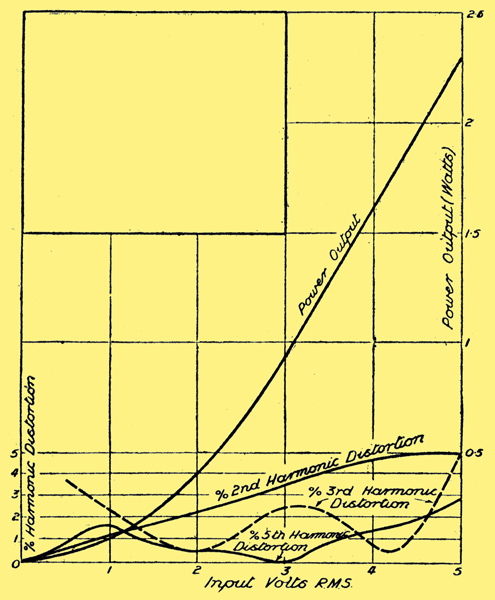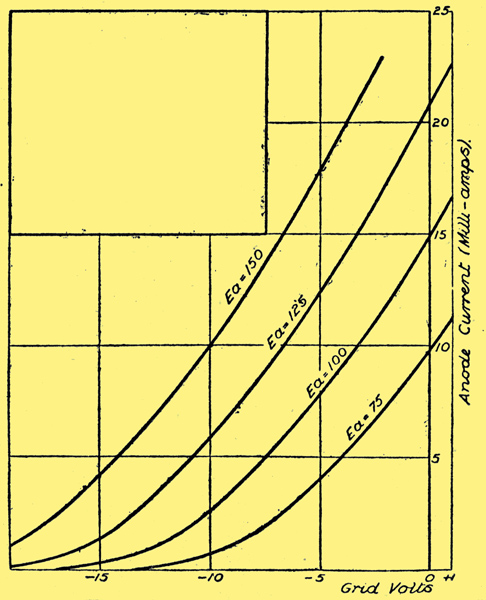|
During the last few months many important valve developments have taken place and the most recent of these are described below.
During the past few weeks numbers of new valves of all sorts have made their appearance on the market. Valves for Class B amplification, for automatic volume control in AC sets, HF pentodes, and so on.
Many of these new valves we have shown in practical application in our set designs, but readers may like to know a little more about them than appears in such constructional descriptions.
We will, therefore, take some of the more out standing types and discuss them a little more fully. First let us consider the last two Mazda valves to appear, the Class B type and the special portable output valve of the straight variety.

This family of curves shows the characteristic of the PD220 Mazda Class B output valve, taken with a P220 driver and 135 Volts on the anodes.
The Class B valve, whose curve you see here, is known as the PD220, and is rated at 2 Volts 0.2 Amp. With a maximum HT voltage of 150 and a suitable driver valve, say the P220, it will give a maximum undistorted output wattage of 2.5 W.
A Small Bias Advisable
It is so arranged that at all anode voltages the valve can be used with zero grid bias, though it is a good plan to use a 0.9 Volt bias cell as a means of reducing the quiescent anode current, especially when a high anode voltage is applied. If this is done a resistance must be placed across the bias battery so that it runs down at approximately the same rate as the HT battery.
The PD220 is a high efficiency valve, for with a driver valve output of only 65 mW we get a full 2.5 W output from the Class stage.
At 120 Volts HT, the most usual voltage for Class B operation, the quiescent anode current of the PD220 should be 2.0 mA, and with a P220 driver valve and transformer ratio of 1.5 to 1 we get a power output of 1.5 W over all. With a smaller driver, such as the L2 and a transformer ratio of 2 to 1 the power output is 1.0 W.
The Ferranti Class B valve, too, is worth careful consideration, for the makers claim the enormous maximum wattage of 3.0 W from the valve. This is obtained with an anode voltage of 150 with a Cossor 215P as driver. With 120 Volts HT the maximum wattage is 2.0 W, while the average anode current consumption is round about 10 mA. The valve is known as the HP2, and is now available.

The Mazda P215, of which curves are shown here, is a special low filament wattage, long grid base output valve designed fer, portable sets.
The new portable set output valve is the Mazda P215, which is a small power valve fitted with a high-efficiency low consumption filament. It takes only 0.15 A, and with a mutual conductance of 1.7 and impedance of round about 4,500 it provides an output of from 60 to 180 milliwatts with HT voltages of from 100 to 150. The grid swing changes at those voltages from 9.0 to 13.5. The anode consumption is 3.0 to 5.8 milliamps, so that the valve is truly ideal for small. consumption battery portables. The optimum load is 15,000 Ω at 100 Volts HT and 11,000 Ω at 150.
The Mullard new high-frequency pentodes are worth careful consideration by set builders. As will be remembered they were used, three of them, in our recently described Four-Pen-Four, and the multi-μ HF pentode is a valve of the highest efficiency.
High Amplification
The valve has the normal type of 4 Volt 1 A heater, and is rated for a maximum HT voltage of 200, with a maximum auxiliary grid voltage of 100. The amplification factor is as high as 5,000 and at the minimum grid bias setting of 1.5 Volts, the mutual conductance of the valve is 2.5.
By increasing the grid bias to -22 Volts, the mutual conductance of the VP4, as the valve is termed, can be reduced to 1% of its maximum value, so the valve is a most efficient multi-μ amplifier of great magnifying powers.
It is more effective than the average SG valve, and as an automatically controlled amplifier it is ideal. In addition, there is the non multi-μ pentode, the SP4, which is an valve of not quite so high an amplification factor, and intended primarily as mixer valve in superhet circuits. It is, however, as was seen in the Four-Pen-Four, an excellent anode-bend detector in ordinary receivers, and can be confidently recommended in such a capacity.
Dual-Purpose Valves
In addition to what may be called the straight valves, we have had several examples of dual-purpose tubes, such as the double-diode triodes and pentodes. These are primarily to provide straight-line rectification of HF, and then to undertake LF amplification so that the diode rectification shall not need any extra valve in the set owing to its non-amplifying properties.
The ordinary leaky-grid detector also amplifies at LF, and most small sets using it need only one following LF valve to provide loudspeaker strength output. In the case of the diode rectifier a further stage of LF is required because the diode does not amplify at all.
It was with the idea of overcoming that difficulty, as well as providing other advantages that the double-diode-triode was designed. This valve, of which Ferranti, Marconi and Osram have at the moment examples on the market, with Mullard following very shortly, provides pure rectification and LF amplification in the one tube, but it also allows a variety of circuits to be used in which either half or full-wave rectification can be carried out, and automatic volume control of different kinds can be included.
These double-diode triodes are known under varying nomenclature according to the make. For instance, the Ferranti valve is called the H4D, the Marconi and Osram valves are listed as MHD4, while the Mullard will be known as the TDD4. Why this variation is necessary I cannot say, it seems a pity, but there it is.
The DDPen
A more complicated arrangement of the double-diode principle has been put on the market by Cossor, in the DDPen, which was used by us in the design of the Double-DPen receiver recently described.
This valve not only incorporates the advantages of the double-diode system, but it includes in the bulb instead of the triode amplifier a multi-μ pentode. This enables automatic volume control, or gain control, as it should really be called, to be carried out on the HF side of the receiver as usual, and also on the LF side, for the multi-μ pentode is subjected to the AVC potentials from the diode in the same way as the HF stages of the receiver.
This is particularly important in that it allows most accurate control of volume to be obtained.
|